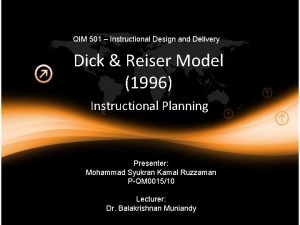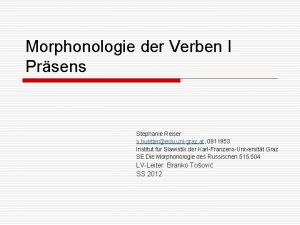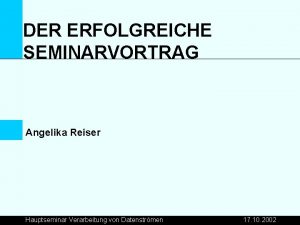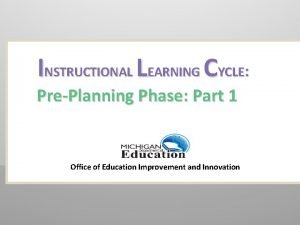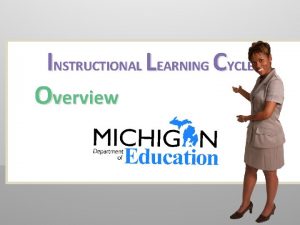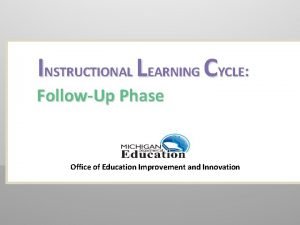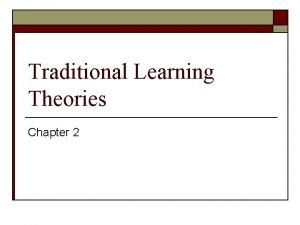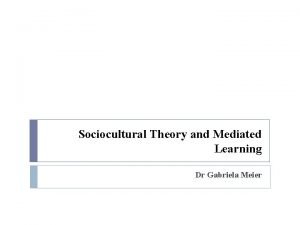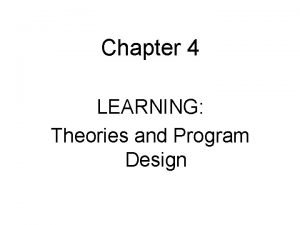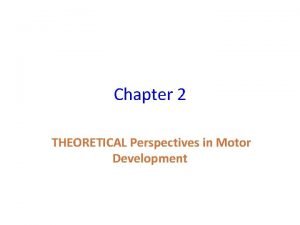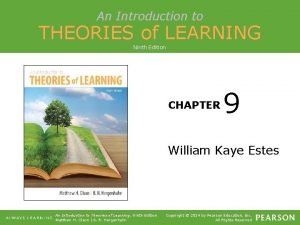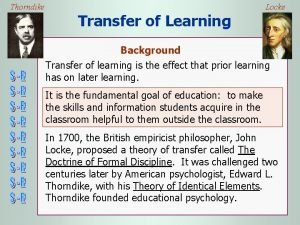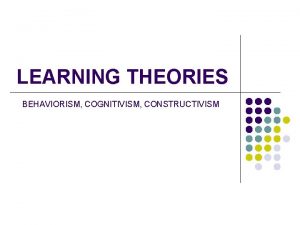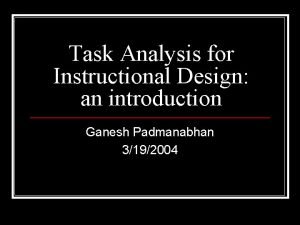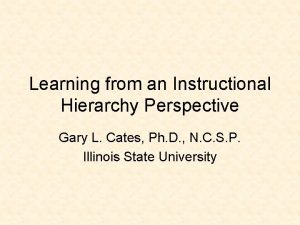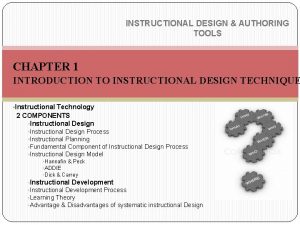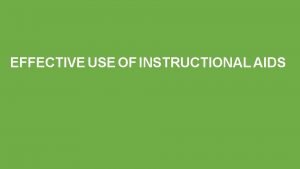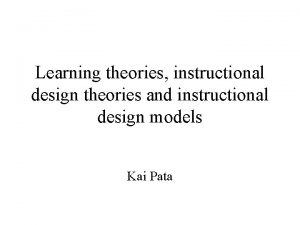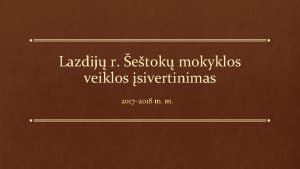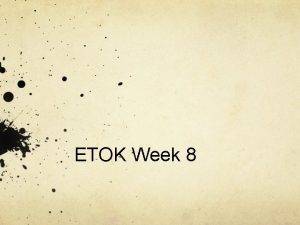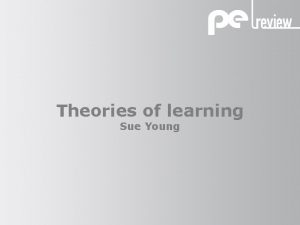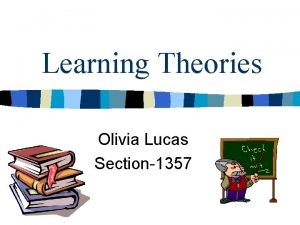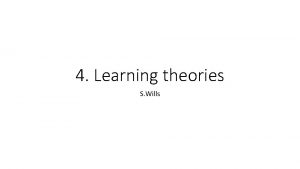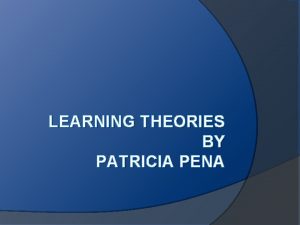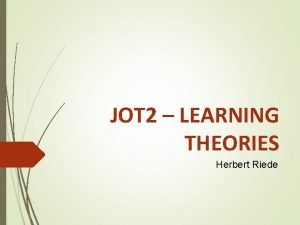ETOK Week1 Instructional Technologies Learning Theories Reiser R



























- Slides: 27

ETOK Week-1 Instructional Technologies & Learning Theories

Reiser, R. A. (2001) A History of Instructional Design & Technology: Part I: A History of Instructional Media

AECT (1963) • "audiovisual communications”, as the central concept of the field, defining it as – "that branch of educational theory and practice primarily concerned with the design and use of messages which control the learning process. ”

AECT (1972) • Educational technology is a field involved in the facilitation of human learning through the systematic identification, development, organization and utilization of a full range of learning resources and through the management of these processes.

AECT (1977) • Educational Technology is a complex, integrated process, involving people, procedures, ideas, devices and organization, for analyzing problems and devising, implementing, evaluating and managing solutions to those problems, involved in all aspects of human learning.

AECT (1994) • Instructional Technology is theory and practice of design, development, utilization, management and evaluation of processes and resources for learning.

Januszewski & Molenda (2013) • Educational Technology is the study and ethical practice of facilitating learning and improving performance by creating, using, and managing appropriate technological processes and resources.

Reiser (2001 & 2012)…Trends & Issues (3 rd Ed. ) • “The field of instructional design and technology (also known as instructional technology) encompasses the analysis of learning and performance problems, and the design, development, implementation, evaluation and management of instructional and non-instructional processes and resources intended to improve learning and performance in a variety of settings, particularly educational institutions and workplace. ” (p. 5)

Instructional Media • The physical means via which instruction is presented to learners (Reiser & Gagne, 1983). – Excluded: teacher, chalkboard, & textbook

History of Instructional Media-1 • School museums • The Visual Instruction Movement & Instructional Films – Edison: “Books will be obsolete in the schools…It is possible to teach every branch of human knowledge with the motion picture. Our school system will be completely changed in the next ten years”

History-2 • The Audiovisual Instruction Movement & Instructional Radio – 1923…Department of Visual Instruction (later AECT) – 1929…Great depression – 1946…Dale’s Cone of Experience

History-3 • World War II – Audiovisual devices in military education – Training films, film projectors, OHP, slide projectors, simulators, etc. • Post-WWII & Media Research – Effects of media were studied, but criticized about the focus.

History-4 • Theories of Communication – Shannon & Weaver (1949)

History-5 • Instructional TV (peak at 1960 s) – Sesame Street – Not adopted to a greater extent – Resistance of teachers – Too many investments

History-6 • Shifting Terminology – 1970 s…Educational or Instructional Technology (instead of Audiovisual Instruction)

History-7 • Computers: 1950 -1995 – CAI – Little impact • Recently – Distance learning, mobile learning, e-learning, etc. – The Internet – Easy access & low cost – Interactivity – Increased multimedia capabilities – Social networking & social media

Reiser, R. A. (2001) A History of Instructional Design & Technology: Part II: A History of Instructional Design

The Origins of ID • WWII – Psychologists and educators • Conduct research and develop training materials • Gagne, Briggs, Flanagan, ….

History of ID-1 • The Programmed Instruction Movement – Early efforts of ID (trial and revision procedures) – Skinner • Small steps • Overt response • Immediate feedback • Self-pacing

History of ID-2 • Behavioral Objectives – Bloom, 1956. . . taxonomy (cognitive domain) – Mager, 1962…preparing objectives for programmed instruction

History of ID-3 • Criterion-Referenced Testing – Norm-referenced: some students doing well on a test and others doing poorly. – Criterion-referenced: how well an individual can perform a particular behavior irrespective of how well others perform.

History of ID-4 • Gagne – Domains of learning – Events of instruction – Hierarchical analysis

History of ID-5 • Sputnik – 1957. . Soviet Union – Scriven, 1967… • Formative evaluation (tryout and revision) • Summative evaluation (test the material after they are in their final form)

History of ID-6 • Early ID Models – Gagne, Glaser, Silvern…. • 1970 s. . . Systems Approach – Peak ID models • Dick & Carey, Gagne & Briggs, Kemp, . .

History of ID-7 • 1980 s…Growth and Redirection – Cognitive psychology in ID process – Microcomputers for instructional purposes • Automate some instructional design tasks – Performance Technology Movement • Front-end analysis • On-the-job performance • Noninstructional solutions

History of ID-8 • 1990 s…Changing views and practices – Focus on performance – Constructivism – EPSS – Rapid prototyping – Internet – Knowledge management

st 21 Century • E-learning • Informal learning • Reliance on informal methods (vs. formal training) – Performance support tools – Online communities of practice – Social media
 Reiser implement
Reiser implement Infinitivstamm
Infinitivstamm Angelika reiser
Angelika reiser Pre planning phase
Pre planning phase Instructional learning cycle
Instructional learning cycle Instructional learning cycle
Instructional learning cycle Cuadro comparativo de e-learning b-learning y m-learning
Cuadro comparativo de e-learning b-learning y m-learning Traditional learning theories
Traditional learning theories Scaffolding theory bruner
Scaffolding theory bruner Learning theories and program design
Learning theories and program design Dynamical systems theory motor development
Dynamical systems theory motor development Humanistic theories examples
Humanistic theories examples An introduction to theories of learning
An introduction to theories of learning Theories of learning thorndike
Theories of learning thorndike Advantages of behaviorism
Advantages of behaviorism Factors affecting learning in psychology
Factors affecting learning in psychology Behaviorism, cognitivism, constructivism connectivism
Behaviorism, cognitivism, constructivism connectivism Task analysis instructional design
Task analysis instructional design Computer sic
Computer sic Demerits of micro teaching
Demerits of micro teaching Maximizing instructional time in the classroom
Maximizing instructional time in the classroom Instructional hierarchy
Instructional hierarchy Marzano 9 instructional strategies
Marzano 9 instructional strategies Instructional design models comparison
Instructional design models comparison Instructional design authoring tools
Instructional design authoring tools Robert marzano high yield strategies
Robert marzano high yield strategies Instructional procedures examples
Instructional procedures examples Instructional aids examples
Instructional aids examples
